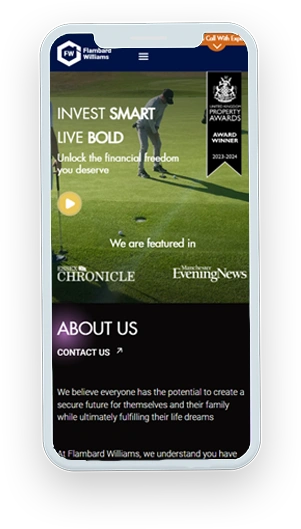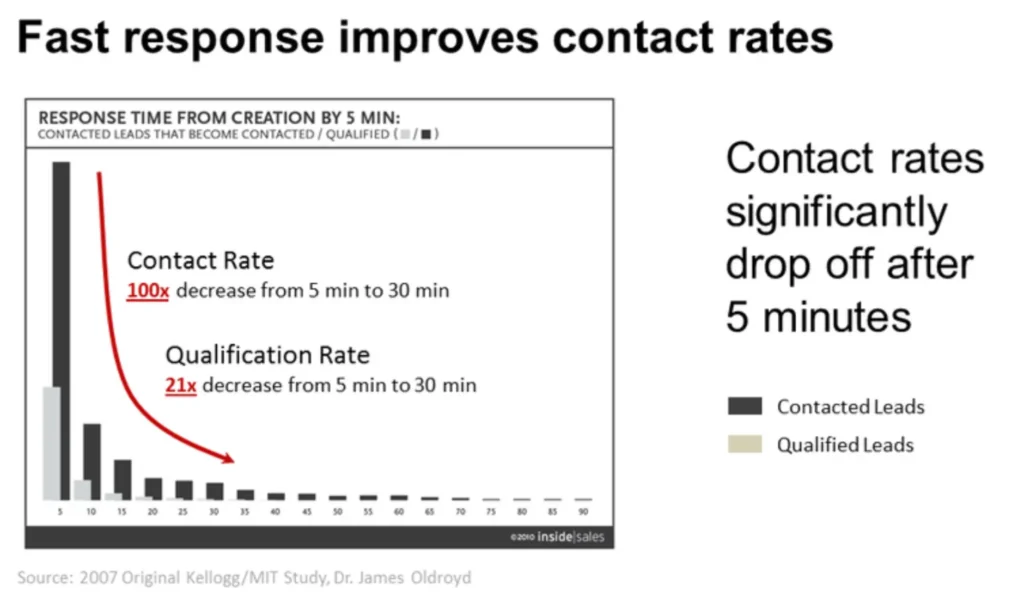How Late Response Times Are Costing Your Business Over 70% of Leads


How late response times are costing your business
Table of Contents
Serious about growing your business? Let’s plan exactly how to get you more leads, sales, and results—faster.

In today’s hyper-competitive digital market, speed isn’t just a luxury—it’s an absolute necessity. If you’re not following up with leads almost instantly, you’re handing your sales opportunities over to your competitors.
Imagine potential customers reaching out, excited about what you offer. Now picture them waiting… and waiting… while your competitors swoop in and steal the deal. Sounds harsh? That’s the reality of slow lead response times.
Recent studies show that nearly 73% of inbound leads are lost simply because companies respond too late. It’s like leaving money on the table.
Even back in 2012, Forbes contributor Ken Krogue warned executives that delays in lead follow-up send prospects into a “black hole,” and the message is clearer now than ever.
People are much more likely to choose the first company that reaches out to them, building trust right from the start.
Slow responses don’t just cost you sales—they hand-deliver them to your competition.
Digital Marketing, SEO & PPC
- SEO to boost rankings and capture high-intent, AI-driven traffic
- Performance Marketing to run ROI-focused campaigns that convert
- Content Marketing to drive clicks, earn links, and build authority

The High Cost of Delayed Responses
Speed Matters Big Time
Ken Krogue in his research says when you follow up with a lead within 5 minutes, your chances of converting that lead skyrocket—it makes them 21 times more likely to convert compared to waiting 30 minutes.
Every extra minute you delay gives your competitors a better chance to step in. In fact, every 10-minute delay can reduce your conversion chances by up to 400% , according to research “The Best Practices for Lead Response Management” published in Harvard Business Review.
This means that in today’s fast-paced market, even a few minutes can make a huge difference in turning an inquiry into a sale.
In essence, even short delays not only decrease the number of leads you engage with but also severely undermine the quality of your interactions.
First Impressions Win
The first response you send can set the entire tone of your relationship with a prospect. Studies have shown that about 78% of buyers choose to work with the very first company that reaches out and responds to their inquiries.
Studies show that acting quickly not only captures attention at the height of their interest but also sets a positive tone (that you’re reliable and ready to help), increasing the chances of success.
This fast action builds trust immediately and often leads to securing 35–50% more sales than competitors who delay. Being the first to engage can be the decisive factor in a prospect’s decision-making process.
Real Numbers, Real Impact
Despite knowing how crucial fast responses are, many businesses still take an average of 47 hours to respond to new leads, according to Forbes.
As a result, only about 27% of leads are ever contacted, which means nearly 73% of potential business is lost because of slow follow-ups.
These figures show the harsh reality: a sluggish response rate doesn’t just slow down your sales process—it actively erodes your bottom line.
Marketing Research & Strategy
We help you understand your market and build smart strategies to attract more customers and grow faster.
- Detailed research into your competitors, customers, and market
- Custom marketing and growth plans that drive real results
- Clear action steps to increase traffic, leads, and sales

ADWORDS ROI
Cut Ad spend

Let’s break down what that really costs:
The average lead response time for website leads is 17 hours, which significantly reduces conversion rates—potentially losing 95% of potential revenue per lead.
Say each customer brings in $100 to your business and you generate 100 leads:
- At a 3% conversion rate (fast response): 3 customers = $300 revenue
- At a 0.15% conversion rate (slow response): 0.15 customers = $15 revenue
That’s a $285 loss per 100 leads—just because of a delayed reply.
These findings aren’t based on guesswork—they come from over 10,000 companies tested across fifteen different “secret shopper” studies conducted over five years.
In each study, researchers submitted real inquiries using valid contact details and tracked how long it took companies to respond, and how persistent their follow-up was.
These insights, originally published by Steve Olenski on Forbes and also featured in the Harvard Business Review and Inc.com.
Fast responders, on the other hand, secure significantly more sales, demonstrating that cutting down response times is not just beneficial—it’s essential for survival in a competitive market.
Why Leads Go Cold
Fading Interest
When a lead reaches out, their interest is at its peak. Delay your response, and that excitement fades rapidly. Prospects may lose focus, start exploring competitors, or simply decide that now isn’t the right time for them.
Competitors on the Prowl
With modern tools and automation, many companies are primed to respond instantly. If you’re not quick, you’re giving your competition the perfect opening to capture the lead before you even get a chance.
Perception of Professionalism
A slow response can send a message that you’re either disorganised or simply not interested. This can tarnish your reputation, making it even harder to win business from that lead in the future.
Why Fast Lead Response Time Is So Important
Fast responses aren’t just about being quick—they help you get the most out of every lead you generate. When a prospect reaches out, they’re at their peak interest, and a quick follow-up can make a huge difference.
By calling back immediately, you connect with prospects while they’re still at their computer or phone, ensuring you capture them right when they’re actively looking for a solution.
Studies show that companies that engage leads in under 5 minutes see much better qualification rates than those that delay.
Responding quickly also helps you stay on a prospect’s mind. Nearly 88% of leads expect a response within 60 minutes, and if you reply promptly, you’re far more likely to be remembered.
A rapid response creates a powerful “Wow Effect.” When prospects receive an almost instantaneous reply—some businesses even achieve callback times under 10 seconds—it leaves a lasting impression, boosting customer satisfaction by up to 25%.
This immediate engagement makes prospects feel valued and reassures them that you’re ready to help with their needs.
Persistence matters too. Research shows that increasing your call attempts to around 9–10 times can improve your chances of making contact by as much as 80% compared to just one or two attempts.
This persistent approach, combined with a fast response, helps ensure that more leads are engaged and eventually converted.
Adding more context, research by Dr. Oldroyd shows that when data from many companies is combined, clear patterns emerge: even a 100x increase in contact ratios can dramatically raise the value of leads, and a 21x increase in qualification rates can have a substantial effect on overall sales revenue.

(here ‘s a graph from original research from Dr. James Oldroyd and InsideSales.com.)
Different industries may have varying optimal call times, but the bottom line is universal—faster responses lead to higher contact rates, better lead qualification, and ultimately, more revenue.
How to Calculate Lead Response Time
To calculate lead response time, use the following simple formula:
Lead Response Time = Time of Contact – Time of Lead Generation
This means you record the exact time when a lead is generated (for example, when they fill out a form or sign up) and the exact time when you first make contact.
The difference between these two timestamps gives you the response time for that lead.
For example, if a lead is generated at 2:00 PM and you contact them at 2:05 PM, the lead response time is 5 minutes.
You can also calculate the average lead response time by summing the individual response times for all leads and then dividing by the number of leads contacted:
Average Lead Response Time = (Sum of All Individual Response Times) / (Number of Leads Contacted)
Tracking this metric is key. It helps you identify delays in your follow-up process and allows you to set clear goals to reduce response times.
A faster response means you capture leads while they’re most interested, ultimately leading to higher conversion rates and better overall sales performance.
Some Additional Leads Response Time Stats You Need to Know
Here are some quick stats you need to know:
- After 5 minutes pass, the odds of connecting and qualifying a lead drop by 80%.
- 55% of companies take longer than 5 days to respond to a new lead, and 12% don’t reach out at all.
- 50% of leads will work with the organisation that contacts them first.
- 90% of leads go inactive after 30 days.
- You have a better chance of connecting with a lead on Wednesdays and Thursdays.
- 30% of your prospects will go to a competitor if you don’t respond quickly.
- Conversion rates are 8x higher in the first five minutes.
- Only 37% of companies achieve a lead response time of one hour or less.
- 44% of leads are generated outside of business hours.
- 82% of customers value quick replies within 10 minutes.
- Using live chat on your website can improve lead conversion rates by as much as 40% compared to email alone.
How to Improve Lead Response Time
1. Invest in Automation
Using CRM systems, AI-powered chatbots, and automated email responders can make a big difference. These tools ensure every lead gets an immediate acknowledgement, which is crucial since chatbots can resolve up to 90% of customer queries quickly.
Also, configure your chatbots to provide humanised responses—like a friendly, natural tone—and offer an easy, straightforward option to connect with a human if the question isn’t resolved, with that transition happening in less than a minute.
2. Streamline Your Sales Process
Mapping out your lead journey helps identify bottlenecks. Leads should be automatically routed to the right sales rep without unnecessary delays. It’s important for your team to understand that responding within minutes is a must.
3. Prioritise Lead Engagement
Train your sales team to act fast. Encourage them to follow up immediately when a lead comes in. During peak hours, consider having a dedicated team for first contact. Push your team to aim for that 5-minute mark to maximise lead capture and engagement.
4. Use Real-Time Marketing Techniques
Adding live chat tools to your website allows you to engage visitors right away. Offering instant booking options or scheduling demos on the spot means leads don’t have to wait. This approach can significantly boost sales; companies that prioritise speed often secure up to 50% more sales.
5. Monitor and Optimise Your Process
Use CRM analytics to track response times regularly. Set clear goals and review them often to ensure you’re not missing leads.
The Verdict
So, what’s the takeaway here?
Put yourself in your potential customer’s shoes. Think about the last time you were shopping online, and filled out a form to get more information about something you were interested in.
Weren’t you most excited to hear back right away? I know you would be! It’s like when you’re hungry and order food – you want it to arrive as quickly as possible. The same goes for potential customers reaching out to your business.
The numbers don’t lie: if you contact a lead within five minutes, they’re way 100x more likely to become a customer than if you wait half an hour.
And guess what? Most people will choose to buy from the very first company that gets back to them. So, if you’re not quick, you’re missing out.
Unfortunately, a lot of businesses are really slow at responding. On average, it takes them over 47 hours to get back to a lead! That’s almost two whole days.
By then, the customer has probably lost interest or gone somewhere else. It’s like letting your food order sit on the counter for hours – nobody wants that!
Want to turn more leads into paying customers? Read This!
You’ll love this case study. It’s a real-world example of how one business massively increased its conversions—just by responding to leads faster.
But it wasn’t just about speed. They took time to truly understand what their customers wanted, did the research, and used smart, proven strategies to turn interest into revenue.
And here’s the best part—you can do the same.
If you’re serious about growing your leads, boosting sales, and staying ahead of the competition, this is one story you don’t want to miss.
Key Citations
- Forbes: Why Companies Waste 71% Of Internet Leads
- Forbes: When It Comes To Inbound Marketing, Time Is Definitely Of The Essence
- Harvard Business Review: The Short Life of Online Sales Leads
- Velocify: Lead Management & Sales Software
- InsideSales.com: Response Time Matters
- Ricochet 360: Lead Response Time Insights
- Podium: Lead Response Time Matters
- Statista: Share of Website Traffic from Mobile Devices
- BrightCall: Improving Lead Response Times
- Chili Piper: Speed to Lead Statistics
- CallPage: Improve Lead Response Time Tips
- Salesforce: Sales Statistics
- SalesLion: Why Companies Struggle to Follow Up Quickly
- Forbes: Step-By-Step Guide To Following Up With B2B Leads Generated By SDRs




